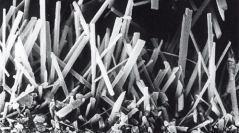

 Geodiversitas
34 (1) - Pages 35-60
Geodiversitas
34 (1) - Pages 35-60Calcareous green algae (CGA) are an artificially united but highly heterogeneous group of large unicellular benthic algae with one character in common: all have the capability of secreting a calcareous coating on the outer side of the cytoplasmic envelope. Today, they are a major contributor to carbonate sedimentation at all scales from clay-sized particles (aragonitic needles) to coarser grains (sand and gravel) and even to plurimetric sedimentary structures. There are fossil analogues to the features listed above. Phycologists know best Halimeda, Penicillus, Acetabularia and Cymopolia; micropaleontologists and carbonate sedimentologists are most knowledgeable about Acicularia, Clypeina, Neoteutloporella, Salpingoporella, Anthracoporella, Boueina, and Eugonophyllum. The CaCO3 precipitated to form the coating is generally aragonite (the orthorhombic form) but there are short periods in the geologic record during which its calcite variant (the rhombohedric form) existed contemporaneously in discrete species. Recent studies on Halimeda have shown that some of the Bryopsidales have the capability to calcify strongly in the lower portion of the euphotic zone (where respiration becomes more important than photosynthesis in the process of mineralization) and to produce positive sedimentary reliefs (bioherms) in situ below the fair-weather wave base. Previous models of paleoenvironments considered the presence of Dasycladales or Bryopsidales to indicate shallow-water, that is the upper euphotic zone (from the sea surface down to –25 m), and predominantly low-energy, protected, lagoonal environments. When the algal remains were found in grain-supported facies, they were taken to have been subjected to dynamic transport and therefore indicative of high-energy environments of deposition. The new deeper-water finds have changed interpretations of the environments ascribed fossil algae. A current conception is that ancestral inarticulated Bryopsidales could have grown at depths as great as –120 m (near the base of the lower euphotic zone). This preliminary review concludes with suggestions about fields for continuing investigations.
Dasycladales, Bryopsidales, Halimeda, bioherm, euphotic zone, phylloid, aragonite, calcite, porosity, epigenesis, cementation